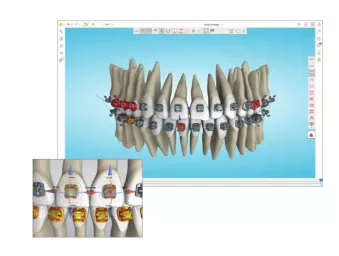
Unsightly Gum Tissue Can Be Treated Non-Surgically To Improve Your Smile
by Dr. Derek Bock
The majority of orthodontic patients come in to see an orthodontist to straighten their teeth and fix other obvious issues such as overcrowding, gaps, overbite, underbite, crossbite, etc. But what many patients don’t often know is getting that “million-dollar smile” can involve more than just aligning teeth, depending on the case.
Some patients also present too much gum tissue when smiling, which, even if all the teeth are properly aligned, can still present an unattractive look. Even a few millimeters of gum-show can distract even the most beautiful set of straight teeth. In my experience, the majority of gummy smile patients who come for consultations often don’t list their gummy smile as a concern because most do not know there is something that can be done about it. For others, it is their single greatest reason for smile dissatisfaction and has made them self-conscious enough to hide their smile, or not smile or visibly laugh, because they are embarrassed by the look. Not wanting to smile or laugh your whole life is a heavy burden no one should have to carry!
Until the last decade, correction of a gummy smile has been lacking in innovation and often meant surgery. But now there less invasive treatments that can yield life-changing results.
What is a Gummy Smile?
First, we should explain what a gummy smile is. When you smile, do you see your upper gum between your teeth and lower part of your upper lip? When you look at a smile that is desirable to you, do you see that there usually is little to upper gum showing?
Although displaying a certain amount of gingiva, or gum tissue, in an open smile is aesthetically acceptable, a smile with more than 2 mm of exposed gingiva is known in the dental field to be a gummy smile. If you have a severe (11-12 mm) or even modest case (4-6 mm), smiling or laughing can make you self-conscious or embarrassed.
How Common are Gummy Smiles?
If you are self-conscious about excessive gum show, you are not alone. According to a paper published in the International Journal of Surgery in December 2017, this condition affects about 11% to 29% of the population depending on age group, with young women from the ages of 15-35 being more affected than others.1
How is a Smile with Excessive Gum Show Treated?
The first thing my patients ask once they learn there is something I can do to help them is, “How do you fix gummy smile?” or “How do you get rid of gummy smile?”
Historically, gummy smile cases have been difficult to treat because they have required jaw surgery — removing a portion of the maxilla — to eliminate excess gum show. Most patients when they hear the treatment requires surgery decline such treatment, let alone that it comes at a high cost and with the risks associated with surgery. Everyone’s goal should be to avoid gummy smile surgery.
The good news is that there are alternative treatment methods to gum surgery today. If you have a smile that shows too much unsightly gum tissue, you should seek a second or third opinion from an orthodontist who is trained and regularly treats your type of issue without surgery and with stunning results. A little research can lead you to a specialist who is trained and experienced in treating gummy smiles non-surgically and who can share outstanding before and after photos of patients like you.
So, what kinds of treatment options for a gummy smile are available? The first step is to have a proper diagnosis from an orthodontic consultation. This will include X-rays, an oral exam and taking a number of pictures. For a small percentage of patients, crown lengthening and gingivoplasty can be effective. Some patients receive temporary treatment with gingivoplasty and BOTOX, but this route does not treat the causes and requires continued and costly injections several times per year for life. And some cases may require surgery to remedy. But there is a far less invasive treatment method for gummy smile than surgery that uses Temporary Anchorage Devices (TADs) to beautifully treat an unflattering smile with very little invasiveness compared to surgery, often in less than 24 months based on what I have observed. This is the treatment approach I like to use with my patients because it can be less costly, less intrusive, and produces fantastic results. I use TADs with a braces system to which they anchor. I also note that most patients also will need gingival contouring as they near treatment completion, as gingival architecture is disrupted to some degree when the maxilla is impacted.
What are TADs and Gingival Contouring?
An orthodontic TAD is a tiny dental implant that looks like a miniscrew that is temporarily placed through the gum tissue and into the jawbone. Although this sounds a bit scary and painful, my patients seem to find this process fairly painless. TADs are usually made of titanium alloy, which is a durable, safe, biocompatible material.
What Causes a Gummy Smile?
You may think the answer to this question is obvious: too much gum tissue. But the answer is actually more complicated and understanding the cause of the excessive gum show is critical for a doctor to determine the correct course of treatment. There are multiple causes for gummy smile, and they all have complex names. But to simplify it, causes range from:
- Excessive gum tissue over the teeth.
- Muscles that make the lip rise higher than it should.
- The upper lip is actually a series of several muscles. If the lip length and muscle strength are causing the lip to ride up higher than ideal, there will be excessive gum tissue shown. The teeth and gums may be at normal height, but the lip is drawing back too far.
- The upper jaw is taller than it should be.
- During growth and development, some people have more growth in the mid-face compared to the rest of the face. The technical term for this is called vertical maxillary excess.
- A combination of these issues.
It’s important to note that although any of these causes can result in a less aesthetically pleasing smile, they usually do not present a functional issue or impact overall oral health.
As an orthodontist, I get enormous satisfaction from the happiness and new-found confidence a beautiful, beaming new smile gives my patients as a result of successful treatment. But gummy smile correction is one of the most rewarding types of cases because the smile transformations can be emotionally and physically life-changing for these patients. If this sounds like a procedure that can benefit you, look for a dental specialist (orthodontist, periodontist) trained and experienced in treating gummy smile non-surgically.
About the Author
Dr. Derek Bock is a board-certified orthodontist who earned his Bachelor of Science as a double major in biology and chemistry from Stonehill. Dr. Derek continued his studies at the prestigious Tufts University School of Dental Medicine in Boston, where he received a Doctorates of Dental Medicine from Tufts University in May 2003.
Following his dental school graduation, Dr. Derek moved to the Midwest to complete his post-graduate training in orthodontics at the University of Illinois at Chicago. He completed a three-year residency in orthodontics and obtained his Master of Science in oral sciences. In addition to his residency, Dr. Derek also completed a one-year fellowship in craniofacial orthodontics at the University of Illinois Craniofacial Center.
It was during this fellowship that Dr. Derek received additional training in dealing with orthodontic problems as they relate to children with craniofacial syndromes, especially cleft lip/palate. Dr. Derek’s scholarly interests include advanced concepts of smile design as they relate to facial balance and harmony. He has done extensive research into the width of the smile as it relates to facial harmony. He has an article pending publication, entitled “The Perception of Buccal Corridors in Smile Esthetics.”


